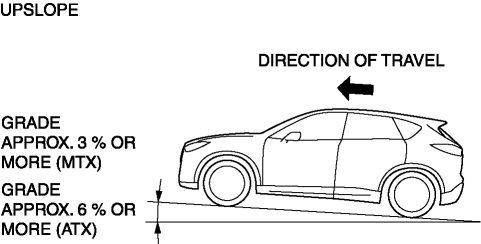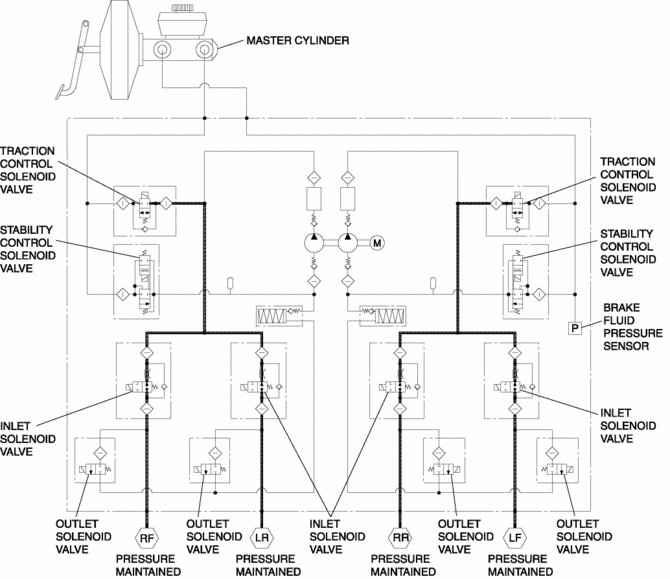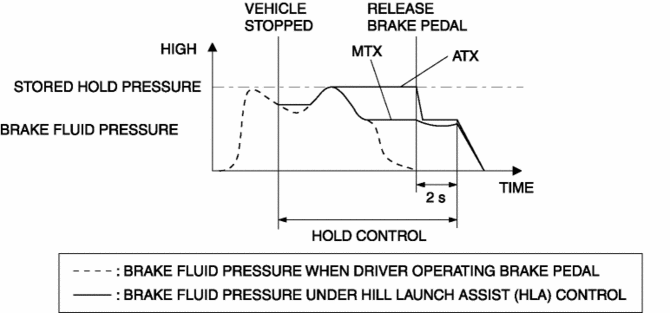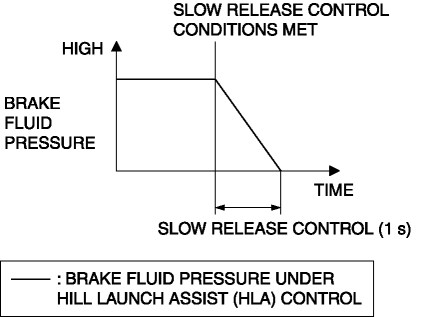Mazda CX-5 Service & Repair Manual: Hill Launch Assist (Hla)
Purpose/Function
-
The hill launch assist (HLA) is a function which assists the driver in accelerating the vehicle on a slope by activating the traction control solenoid valve in the DSC HU/CM when the vehicle begins accelerating on a slope, and maintaining/reducing brake fluid pressure to prevent the vehicle from rolling for a specified time.
-
The system automatically operates when the vehicle is stopped on a slope of approx. 3 % or more (changes slightly depending on load and vehicle conditions such as tire wear and air pressure). (MTX)
-
The system automatically operates when the vehicle is stopped on a slope of approx. 6 % or more (changes slightly depending on load and vehicle conditions such as tire wear and air pressure). (ATX)
NOTE:
-
The shift lever position is in the other than R position, the hill launch assist (HLA) operates on a upslope. (MTX)
-
The selector lever position is in the D/M position, the hill launch assist (HLA) operates on a upslope. (ATX)

-
The selector/shift lever position is in the R position, the hill launch assist (HLA) operates on a downslope.

-
The hill launch assist (HLA) operates constantly without affecting the TCS OFF switch operation.
-
When the parking brake is applied, the hill launch assist (HLA) does not operate.
-
When the DSC indicator light illuminates, the hill launch assist (HLA) does not operate.
-
Structure
-
The hill launch assist (HLA) constantly controls the brake fluid pressure in accelerating the vehicle on a slope by determining the hill launch assist (HLA) operation based on the signals input from each module via CAN communication, wheel speed signals from the ABS wheel-speed sensor.
Block diagram

Hydraulic circuit diagram

Operation
-
If all of the following conditions are met while the vehicle is stopped on a slope, the DSC HU/CM performs controls to maintain brake fluid pressure (control the linear control solenoid valve) even if the driver has released the brake pedal.
Hold control
-
Control conditions (all of the following conditions met):
-
Engine speed is at a certain value or more
-
All doors are fully closed
-
Slope of approx. 3 % or more (MTX)
-
Slope of approx. 6 % or more (ATX)
-
Wheel speed is 0 km/h {0 mph}
-
Parking brake not operated
-
Accelerator pedal not depressed
-
Not fail-safe mode is present
-
Upslope: The selector lever position is in the D/M position (ATX)
-
Upslope: The shift lever position is in the position other than R (MTX)
-
Downslope: The selector/shift lever position is in the R position
-
Brake pedal is depressed and brake fluid pressure is at a certain value or more
-
Clutch pedal depressed (MTX)
-
Control description
-
If all of the control conditions are met, the DSC HU/CM controls the traction control solenoid valve and maintains brake fluid pressure (driver can depress brake pedal more at this time).

-
If the brake pedal is released, brake fluid pressure (hold-pressure stored in memory) is maintained for a maximum of 2 s.
Release control
-
Control condition
-
After the accelerator pedal is depressed, the required engine torque for accelerating vehicle on a slope is produced
-
Control description
-
Brake fluid pressure being maintained is lowered depending on produced engine torque.

Slow release control
-
Control condition (one or more of following conditions are met):
-
Parking brake applied
-
Clutch pedal released (MTX)
-
DSC HU/CM has malfunction (performs slow release control only if solenoid valve control is available)
-
0.2 s has elapsed on slope of 1.0 % or less
-
2 s have elapsed with brake pedal released
-
Control description
-
Brake fluid pressure being maintained is lowered in 1 s

Fast release control
-
Control condition
-
DSC HU/CM has malfunction and solenoid valve control is not available
-
Control description
-
Brake fluid pressure being maintained is reduced to 0 kPa {0 mmHg, 0 inHg} immediately
 Ebd Control
Ebd Control
Outline
EBD control uses the ABS system to control brake fluid pressure distribution
to the rear wheels so that they do not lock-up prior to the front wheels during
braking, thereby preve ...
 Precaution [Dynamic Stability Control (DSC)]
Precaution [Dynamic Stability Control (DSC)]
1. The ABS warning light and/or brake system warning light and/or TCS/DSC indicator
light and/or TCS OFF indicator light illuminate even when the system is normal.
Warning ...
Other materials:
Rear Drive Shaft Removal/Installation
CAUTION:
Performing the following procedures without first removing the ABS wheel?speed
sensor may possibly cause an open circuit in the harness if it is pulled by
mistake. Before performing the following procedures, remove the ABS wheel?speed
sensor (wheel side) and fix it to an ...
Precaution [Dynamic Stability Control (DSC)]
1. The ABS warning light and/or brake system warning light and/or TCS/DSC indicator
light and/or TCS OFF indicator light illuminate even when the system is normal.
Warning lights/Indicator lights that may illuminate and/or flash
Cases in which the light may ill ...
Shift Solenoid No.2 [Fw6 A EL, Fw6 Ax EL]
Purpose/Function
Shift solenoid No.2 adjusts the hydraulic pressure in the 2-6 brake circuit
based on the current demand from the TCM according to the vehicle conditions.
Construction
Shift solenoid No.2 is installed to the solenoid control valve body.
Shift solenoid N ...
